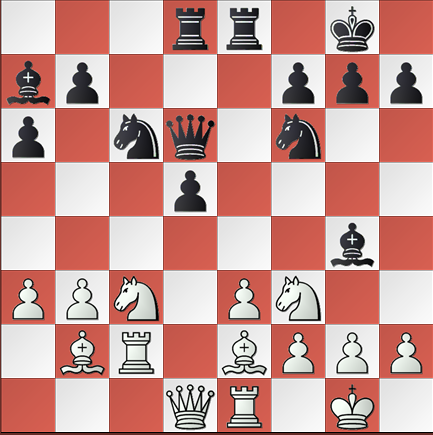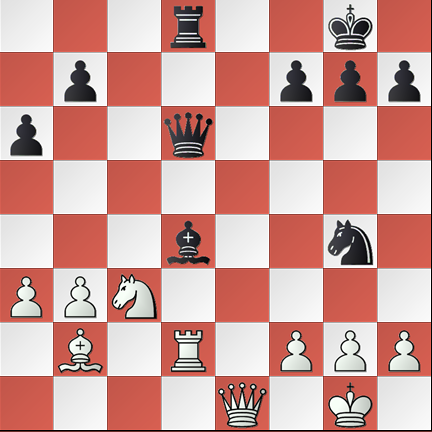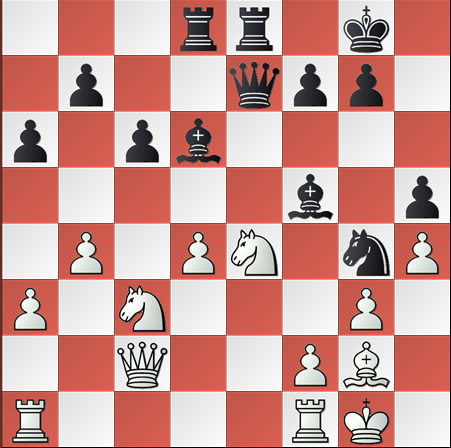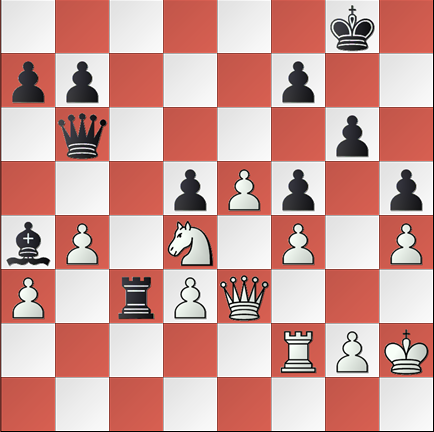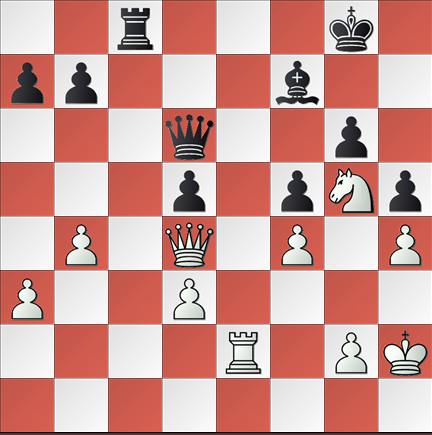Before learning more about the nitty-gritty aspects of this classic bishop sacrifice, let us explore one more game in the same category in a more systematic way for better understanding of this idea of attacking the castled king with bishop.
The position of the game is given hereunder:
(White to move)
It is the turn of White to move and he launches the attack straightaway.
| 1. | Bxh7+ | Kxh7 |
| 2. | Ng5+ | …. |
As stated earlier, let us analyze the game in a systematic way and try to explore all possible variations at the disposal of the black King and White’s response to those moves.
A cursory look at the position reveals that the black king has three options, in fact four options, at his disposal.
Black King can move either of the following four squares – g8, h8, g6 and h6.
Moving to h8 might not yield any result as the White can place his queen at h5 and threaten with check. Black king has no other option but to move to g8 and Queen’s next move to h7 is mate. So, this option is ruled out, in the first instance.
Let us look at the other three options.
Variation #1 – moving the king to g8:
The moves in this variation would be as follows:
| 2. | …. | Kg8 |
| 3. | Qh5 | Re8 |
| 4. | Qxf7 | Kh8 |
| 5. | Qh5+ | Kg8 |
| 6. | Qh7+ | Kf8 |
| 7. | Qh8+ | Ke7 |
| 8. | Qxg7# | 1 – 0 |
In this variation, White has used the pawns at h7, f7 and g7 as the primary points and relentless less pressure on the Black king with a series of checks ensures victory for the White, at the cost of the bishop sacrifice at h7.
Variation #2 – moving the king to h6:
The moves in this variation would be as follows:
| 2. | …. | Kh6 |
| 3. | Qg4 | Rh8 |
| 4. | Nxe6+ | Kh7 |
| 5. | Qxg7# | 1 – 0 |
Here white might also consider using the discovered check in the third move itself instead of Qg4 and capture the black queen, while ensuring that victory is assured.
Variation #3 – moving the king to g6:
This is one variation where black has some sort of chance to extend the game and force any mistakes from white.
| 2. | …. | Kg6 | |
| 3. | h4 | Rh8 | |
| 4. | h5+ | Rxh5 | |
| 5. | Qd3+ | f5 | |
| 6. | exf6+ | Kxf6 | |
| 7. | Qf3+ | Ke7 | |
| 8. | Qf7+ | Kd6 | |
| 9. | Qxh5 | …. | White can win from this position |
Now, we have explored the game in its entirety with all the possible variations, and can conclude that this classic bishop sacrifice would be worth considering for attacking the castled king.
However, one needs to exercise great caution as any wrong calculation or non-satisfaction of any condition might jeopardize the entire plan and would backfire abruptly.
Before considering this option, one should question himself whether the sacrifice of the light squared bishop at h7 is feasible or whether it would yield the desired outcome. The answer for this question lies in the satisfaction of certain specific conditions, both from the perspective of the location of white pieces as well as black pieces. If there is any deviation in this basic position that need to be fulfilled, there is no guarantee that the sacrifice would yield the desired results. In Part 4 of classical bishop sacrifice we will look at things to consider before going for the bishop sacrifice.
